 |
The Hissem-Montague Family  |
 |
The Hissem-Montague Family  |

Below I trace the maternal heritage of my mother, Jeanne Katherine Offerman. Afterwards I'll go through the female line of my wife, Anita Montague Hissem.
Jeanne Katherine Offerman's mtDNA ProfileMitochondrial DNA (mtDNA) tracks the female descent, just as Y-DNA tracks that for the male line. However, whereas Y-DNA starts its nomenclature with haplogroup A, in MtDNA we begin with L; I don't know why. The most recent common ancestor in the human female line, the mitochondrial Eve, was the originater of haplogroup L. She was not the first woman, but she is the mother of us all because the female descent of all of her contemporaries died out before today. She lived about 160,000 years ago in East Africa, perhaps more specifically in today's Tanzania. L is still the most common haplogroup in sub-Saharan Africa.
Haplogroup L has seven subclades, L0-L6, of which L3 denotes the out-of-Africa movement. The descendents of L were M and N, which encompass all non-African haplogroups. From M evolved C, Z, D, E, G, and Q. From N evolved O, A, S, R, I, W, X, and Y. From R evolved B, F, H, V, J, T, P, K, and U.
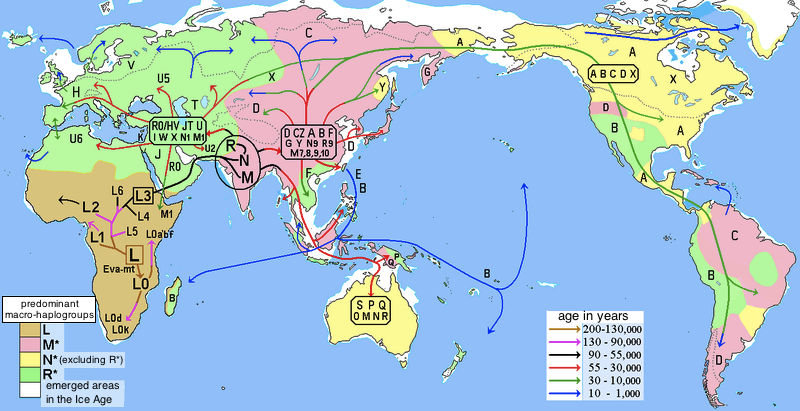
My Mom's mtDNA haplogroup is K1a4a1h.
K emerged in West Asia as a subclade of haplogroup U8b during the Upper Paleolithic, between 20,000 and 38,000 years ago. This type is not found among the ancient remains of the Paleolithic hunter-gatherers of Europe.
K1 probably arose in the Middle East during the later Paleolithic.
K1a is thought to have arisen around 19,000 to 22,000 years ago. It is the most common subclade of the haplogroup in Europe. It is found, along with K1b and K2a, among the early Neolithic farmers of the Near East and subsequently of the Early European Farmers.
"It is now certain that haplogroup K was a major maternal lineage of Neolithic farmers and herders before they entered Europe.By the way, Otzi, the Alpine mummy, was Y-DNA haplogroup G2a and mtDNA haplogroup K1f.
Fernandez et al. (2014) tested the remains of 15 individuals from the Pre-Pottery Neolithic B site of Tell Halula (6800-6000 BCE) and Tell Ramad (6000-5750 BCE) in Syria, and identified six members of haplogroup K (40%). Lazaridis et al. (2016) tested Neolithic farmers from Jordan and western Iran, while Kiliinc et al. 2016 analysed genomes from Neolithic central Anatolia. Both of them found numerous K1a samples, belonging notably to the subclades K1a4b (in Jordan) and K1a12a (in Turkey and Iran).
Mathieson et al. (2015) tested the genomes of 26 Early Neolithic farmers from the Barcin site (6500-6200 BCE) in north-western Anatolia, and among them were 8 members of haplogroup K (31%), including K1a1, K1a2 (2x), K1a3a, K1a4 (2x), K1a6, and K1b1b1. Hofmanova et al. (2015) tested five more Neolithic farmers from the same period, two from the same site in Turkey and three from Greece, and one K1a2 sample turned up in each country.
Haplogroup K was found in approximately 15% of the hundreds of Neolithic samples from Europe, a frequency twice higher than among modern Europeans. The frequency decreased over time as farmers mingled with aboriginal European people descended from Mesolithic fishermen, hunters and gatherers." - from Maciamo Hay at eupedia.com.
K1a4 was found at Barcin, a Neolithic site in northwestern Anatolia, and was probably the most common subclade among Neolithic farmers in Europe. Its distribution in Europe hints at a dispersal during the Linear Pottery culture, which diffused farming throughout Germany and northern France. It is from this culture that agriculture reached the British Isles and Scandanavia.
K1a4a is found in central and southeastern Europe.
K1a4a1 is found across Europe. One set of remains discovered of the Cardium Pottery culture of Catalonia were K1a4a1, as was one of the Linear Pottery culture of Alsace (K1a4a1e), and also one, more interestingly, from the Salzmunde group of the Funnelbeaker culture (K1a4a1a2). The latter was centered in the Saale-Elbe region of Germany, just north of Leipzig.
K1a4a1h.
The following is an old list of haplogroup K found in ancient remains. I've concentrated on its possible place of origin, movement west and north, and evolution in central Europe.
NeolithicToday, in Europe, mtDNA K is particularly common in Northwest Europe, with peaks observed in Belgium (14%), Ireland (12%), the Netherlands (10%), Iceland (10%), Denmark (9%) and France (8.5%). K1a4a1 is the most common subclade of K in Europe.
Syria
Pre-Pottery Neolithic Tell Halula (6800-6000 BC) 2 samples H/K + 2 samples K?
Pre-Pottery Neolithic Tell Ramad (6000-5750 BC) 3 samples K
Anatolia
Pre-Pottery Neolithic Boncuklu samples of K1a
Pre-Pottery Neolitich Barcin Hoyuk 11 samples of K1a and K1a4
Czech Republic
LBK (5300 BC) 3 samples of K
Germany
LBK? (5000 BC?) 1 sample of K1a + 1 sample of K2a5
LBK (5000 BC?) 6 samples of K + 7 samples of K1a
Schoningen (4100-3950 BC) 3 samples of K + 6 samples k1a
Baalburge (3950-3400 BC) 2 examples of K1a
Salzmunde (3400-3025 BC) 1 sample K1; 1 sample K1a; 1 sample K1a4a1a2
Bernburg (3101-2919 BC) 2 samples K1a
Bernburg (3100-2650 BC) 1 sample K1
France
Treilles (3000 BC) 2 examples K1a
Megalith (2750-2725 BC) 1 example K + 1 example of K1a
Chalcolithic
Italy
Unspecified [Otzi] (3350-3100 BC) K1f
Germany
Forager/Funnel Beaker (3200 BC) 1 example K
Corded Ware (2260-2203 BC) 1 sample of K2a5
Corded Ware (2600 BC) 1 sample K1a24a
Corded Ware (2600 BC) 1 sample K1
Corded Ware (2600 BC) 2 samples (?) of K1
Corded Ware (2500-2400 BC) 1 sample of K
Bell Beaker (2600-2500 BC) 1 sample of K1
Bell Beaker (2500-2050 BC) 1 sample of K
Switzerland
Corded Ware (2500 BC) 1 sample of K
Bronze Age
Germany
Unetice (1653-1627 BC) 1 sample of K
Unetice (2200-1550 BC) 1 sample of K; 1 sample of K1a
Unetice (2133-2080 BC) 1 sample of K2
Iron Age
Germany
La Tene (400 BC) 2 samples of K; 1 sample of K1a
Denmark
Unspecified (200 BC) 2 samples of K
Medieval
Denmark
Viking (1000 AD) 1 sample of K
Unspecified (1250-1450 AD) 1 sample of K
Germany
Slavic? (1200 AD) 2 samples of K
Poland
Unspecified (900-1400 AD) 1 sample K1; 1 sample of K2
England
Unspecified (1347-1351 AD) 1 sample of K1a1b1
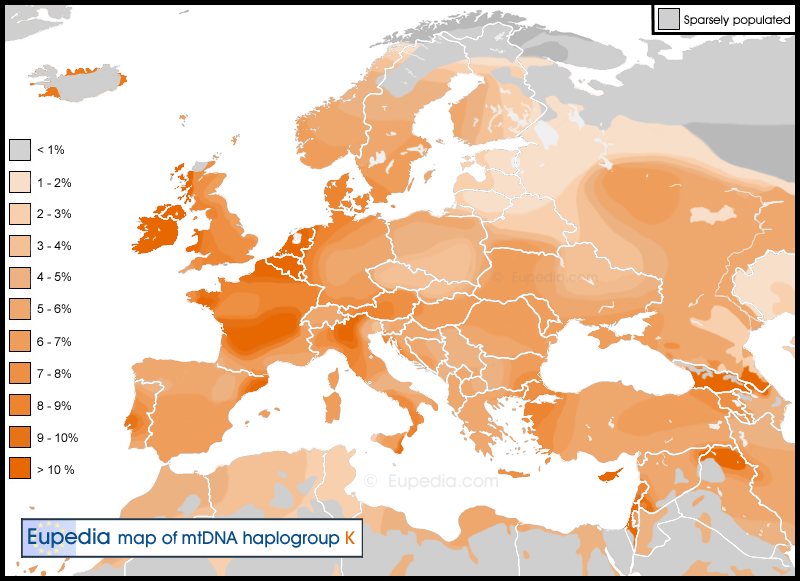
My current thinking on my mom's family's trek across Europe is below.
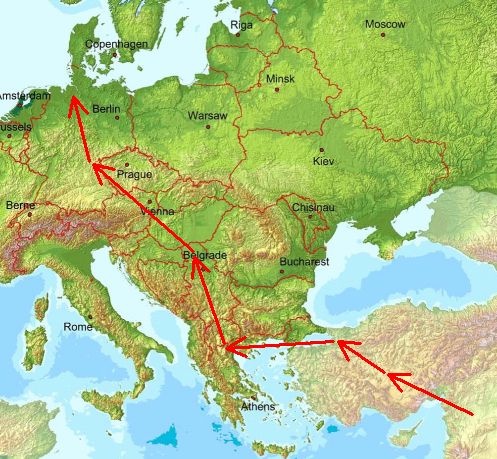
My mom's mother-line is, so far, 100% German; they were in fact all Holsteiners. I have relied on the work of others at www.gottschfamily.net, familysearch.org and rootsweb.com to construct this descent. As we go back in time its validity becomes less certain, especially generations 13-15.
| Holstein, Germany
The term "Holstein" comes from the Old Saxon, Holseta Land, meaning "woodland." This was to distinguish it from neighbouring regions in the area which were either marshy or green pasture lands. The Saxons called the inhabitants Holsaten. From that the Romans derived the name Holsatae. The other Saxon tribes in the region north of the Elbe river were the Tedmarsgoi, or Dithmarschers who settled in the west of the country on the North Sea coast, and Sturmarii/Sturmera, or Stormaren, who settled in the south of Holstein. The Germanic tribe known to history as the Angles, invaders of England in the Fifth century, came from this region, known to the Germans as Angeln.
The people historically spoke a dialect of German known as Low Saxon or Low German, also referred to as Plattdeutsch. When the Prussians seized the duchy in 1866 the populace was forced to adopt the High German language, the modern German language of today. The major cities are Kiel and Lubeck, with the major urban center of Hamburg lying just outside the region to the south, on the Elbe. Holstein, and its northern neighbor Schleswig, have always been torn between their Germanic and Scandavian roots. Peopled by Saxons, Danes, Jutes, Frisians and Slavs, they have been ruled by the dominant power in the region. From 1773 the Kings of Denmark held both duchies; Schleswig as full sovereign, Holstein as a prince of the Holy Roman Empire. Both duchies were in personal union with, but not part of, Denmark. The Congress of Vienna, held after the end of the Napoleanic Wars in 1814-15, did not change the status of the two duchies, except that the German Confederation, which had succeeded the Holy Roman Empire, now became suzerain over Holstein. Because of the growing national consciousness of the German people in the 19th century, and of the predominantly German population in the two duchies, any change in their status that would tie them more closely to Denmark was a potentially explosive issue. When King Christian VIII announced, in 1846, that succession by females was to apply not only to the Danish throne but to Schleswig as well, there was violent opposition among German nationalists who feared the complete incorporation of Schleswig into Denmark. Nevertheless, under pressure from Danish nationalists, Frederick VII, who had succeeded Christian, declared the complete union of Schleswig with Denmark in 1848. Revolution broke out in both duchies, a provisional government was established in Kiel, and the German Confederation came to the aid of the rebels and occupied the duchies in what became known as the First War of Schleswig. British intervention led to an armistice in the German-Danish fighting, but in 1849 the war was resumed. After inconclusive fighting, peace was made in 1850 between Prussia, which had been commissioned by the Confederation to conduct the war, and Denmark. Nothing had been solved however and tension continued to run high in the duchies.  In 1855 pressure from Danish nationalists forced Frederick VII to proclaim the Danish constitution as valid for both duchies. The protest of the German Confederation led to the withdrawal of that measure, but in November 1863, just before Frederick's death, a common constitution for Denmark and Schleswig was drawn up. His successor, Christian IX, signed the constitution, which the German diet declared in violation of the protocol. In January 1864 Prussia and Austria declared war on Denmark, which was easily defeated. Austria was initially given control of Holstein, while Prussia was given Schleswig, but as a result of Prussia's victory over Austria in the Seven Weeks War, both duchies were annexed by the Prussian's in 1866. After World War I a plebescite was held. Northern Schleswig voted to reunite with Denmark while southern Schleswig and Holstein voted to remain part of Germany. |
She married Jochim Stuhr (1614-1659), the son of Pasche Stuhr (1570). The Stuhr line gets traced back to Ehler (Eler) Stuhr who was born before 1405 in Brodersdorf, Probstei. How they know all this I can't imagine.
Generations 13 through 21 were Probsteiers. These were the residents of a small area east of Kiel, on the Baltic Sea coast, in the district of Plon, in Schleswig-Holstein, Germany. This was the former Duchy of Holstein. Predominant names there are Arp, Ewoldt, Finck, Gottsch, Klindt, Lamp, Lage, Muhs, Puck, Schneekloth, Sindt, Sinjen, Stoltenberg, Stelck, Steffen, Stuhr, Untiedt, Voge, and Wiese.
From generation 22 on are Americans.
The Probstei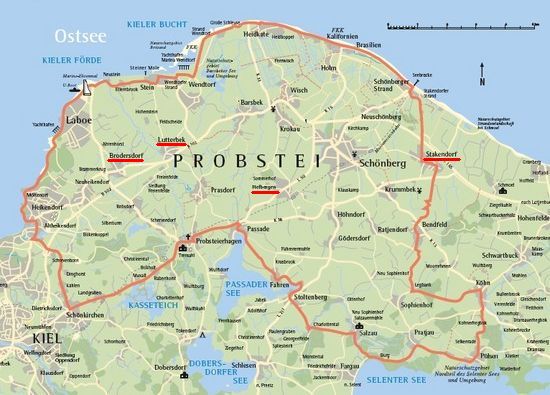
The inhabitants of the Probstei, known as Probsteiers, appear to have come originally from the area around Harsefeld, in Lower Saxony. The area's history begins in 1226 when the Count of Schauenberg, Adolf IV, gave the northern part of the modern-day district of Plon to the cloister of the Benedictine Order in Preetz. This area was named Probstei because it was under the administration of the provost of the cloister, known in German as the Probst. "The colonisation of this area began in the 13th century. Between 1246 and 1250, the provost of the monastery in Preetz, Friedrich, called settlers into the area. One theory goes that they came from around Harsefeld, some 20 miles southwest of Hamburg. Friedrich had been in office there before he was installed as provost in Preetz. The Probsteiers were known to speak a peculiar dialect of Low German (Plattdeutsch), and used words that were untypical of the area in eastern Holstein. Linguists would point to an area along the Elbe-river, which would strongly support the theory about Harsefeld as their origin. So I heard and read.They were free farmers, not serfs, and had a tight knit community. Intermarriage within the Probsteier community was quite high and continued after emigration. The Iowa marriage register shows many Stoltenbergs, for instance, marrying with old Probstei families such as the Arp, Muhs, Sindt, Untiedt, and Wiese. Harsefeld
|
Engelke was born in 1633 in Brodersdorf, Holstein, the daughter of Jochim Stuhr (1614-1659) and Catrina N (1614-). Her father had been born before 1614 in Brodersdorf. Engelke married Jochim Grumm/Gromm (1633-1691). He was a Hufner und Bauernvogt, a farmer and village mayor, born in Lutterbek. Engelke died in 1693.
(15) Anna "Antje" Gromm (1660)Grumm, 1660-1730, of Lutterbeck, Holstein, the daughter of Jochim Grumm/Gromm (1633-1691) and Engelke Stuhr (1634-1693). She married Hans Schroder (1653). This seems a bit dodgy. Anna Gromm seems too young to have a daughter, Grete, below. I'd be happier if she were her husband's age.
(16) Margrete "Grete" Schroder (1673)Schoeder, 1673-1721, of Lutterbeck, Holstein, the daughter of Hans Schroder (1653-) and Anna Grumm/Gromm (1660-1730). She married Clas Voge (1670-1719).
(17) Anna "Antje" Voge (1712)Of Stakendorf, Holstein, the daughter of Claus Voge (1670-1719) and Grete Schroder (1673-1721). She married Clas Goetsch (1710-).
(18) Catherine "Trin" Goetsch (1736)Gotsch, Gottsch, Gottsche. Trin was born on 28 February 1736 in Stakendorf, Holstein, the daughter of Clas Goetsch (1710-) and Antje (Anna) Voge [perhaps]. Trin married Claus Ladehoff on 6 May 1756 in Schonberg. He was born on 1 November 1731 in Fiefbergen, the son of Claus Ladehoff Sr. (1697/1705-1753) and Gretje Wiese (1707-1779). Trin died on 25 February 1796 in Fiefbergen. Claus died on 24 August 1779.
(19) Catherine "Trin" Ladehoff (1771)Catherine Ladehoff was born on 1 September 1771 in Fiefbergen, the daughter of Claus Ladehoff (1731-1778) and Trin Goetsch (1736-1796). She married Peter Schneekloth on 14 September 1793 in Schonberg. Peter was born on 5 March 1765 in Fiefbergen, the son of Heinrich Schneekloth and Gretje Wiese [?]. Peter died on 8 August 1839 in Fiefbergen. Catherine died on 13 February 1839 in Fiefbergen.
(20) Catherine "Trina" Schneekloth (1798)Trin was born on 19 September 1798 in Fiefbergen, Holstein [Fiefbergen is just southwest of Schonberg], the daughter of Peter Schneekloth and Trin Ladehoff of Fiefbergen. She married Hinrich Stoltenberg on 9 November [6 December?] 1818 in Schonberg. Hinrich was born on 2 April 1786 in Fiefbergen, the son of Hinrich Stoltenberg Sr. and Gretje Finck. The family lived in Fiefbergen.
Their children were Margaretha (1819), Hinrich Jr. (1822), Peter (1823), Heinrich (1827), and Catherina (1831).
A Catharine Stoltenberg, 72 [1798], born in Holstein, died at home of 'old age' in May 1870 in Davenport, Iowa and was buried there. When did she emigrate? Hinrich died . . .
(21) Catherine "Trina" Stoltenberg (1831)Catherine was born on 23 April 1831 in Fiefbergen, Plon, Schleswig-Holstein, Germany, the daughter of Hinrich Stoltenberg (1786-?) and Trina Schneekloth (1798-1869). Catherina emigrated no later than 1850, when she married Frederick August Rochau [Rochan] (1829), of Rendsburg, Rendsburg-Eckernforde, Holstein, on 22 October 1850. Frederick was born on 2 November 1829, the son of Hans Christian Rochau, of Rendsburg, and Catherina Trina Luthje, of Osterronfeld, Rendsburg-Eckernforde. I do have a Catherine Stoltenberg, aged 16 [1831], who arrived in New Orleans from Hamburg onboard the bark HARRIET on 9 June 1847. However, she was listed as being from Wisch, in the Probstei. She was accompanied by a Peter Stoltenberg, a 22 year old workman, also from Wisch. He was not Catherine's husband; perhaps her brother.
| Emigration from Holstein and the Probstei
Probsteiers were the first noteworthy group of emigrants from Holstein to America. The first emigration out of the Probstei occurred in 1847. "In the spring of 1847 two great groups of Emigrants left the Probstei. One group of 94 individuals left the Probstei on the ship "Henriette" in April. The newspaper, "Husumer Wochenblatt," printed on 2 January 1848, "40 individuals of this 94 passed away because a high fever on their way from New Orleans to Davenport [Iowa]. They are buried upstream of the river Mississippi." - from a book of Dr. Paul-Heinz PausebeckThe emigrants took a steamboat from New Orleans to Davenport, Iowa, arriving on 21 June 1847. "After 1848 [sic] (gold rush in California and the uprising of 1848-51 in Schleswig-Holstein) the first significant wave of Schleswig-Holstein emigration to the United States occurred. These emigrants settled in the vicinity of Davenport, Iowa [yep, that's my mom's home town!]. They were farmers who were eligible to obtain land if they were able to cultivate it. It cost between 400 to 1000 Dollars and hard work to establish oneself and flourish. The emigrants were mostly young men between 17 and 25 years of age." - from WikipediaMore emigration followed. "The early presence of Schleswig-Holsteiners triggered a chain migration to Davenport in succeeding years. Carl August Ficke, Davenport's mayor from 1890 to 1891, remembered the sensation the letters from America caused in his hometown: "The letters described an earthly Paradise . . . [They] passed from hand to hand and were eagerly read. They were copied numberless times . . . these immigrants would leave a huge cultural imprint on Davenport, soon making it the most German city in the Midwest . . ." - from "A Brief History of Bucktown: Davenport's Infamous District Transformed" by Jonathan Turner There is a town named Probstei just northwest of Davenport, Iowa as well as another town named Holstein. |
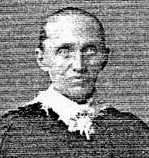 To the left is a photo of Catherine Stoltenberg Rochau in later life. To the right is a photo of Frederick Rochau.
To the left is a photo of Catherine Stoltenberg Rochau in later life. To the right is a photo of Frederick Rochau.
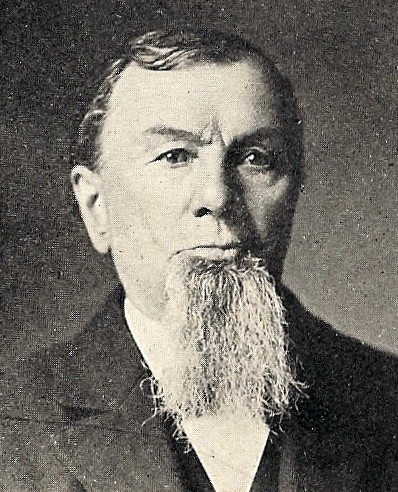
In the 1870 census of Sheridan, Scott county, Iowa, the surname transcribed as Rogge. In the 1880 census of Sheridan, the surname transcribed as Roehal.
In the 1885 state census for Sheridan, Scott county, Iowa as Cathrina Rochau, 54. She was living with her husband, F.A. Rochau, a 55 year old farmer, and children, Minnie, 21, Louisa, 16, John, 15, Ella, 13, Henry, 7, Louis, 7.
It appears that Fritz and Cath.a Rochau, of Davenport, went back to Germany for a visit, returning home on FURST BISMARCK on 11 July 1895. Fritz was described as a Rentier, that is a person who lived on the income from his properties or securities.
Trina died on 25 March 1897 in Scott county, Iowa.
In the 1900 census of Davenport, Scott county, Iowa as Frederick A. Rochau, a 70 year old widower [November 1829]. Living with him was his daughter, Minnie, 39 [December 1860].
Frederick, 79, died on 4 December 1908 in Davenport, Scott county, Iowa.
Her children were Charles, Julia [Juergensen], Mina, Emma [Dengler], Lydia [Borgelt], Louise [Kistenmacher], John, Ella [Bell], Allen, Henry, and Louis.
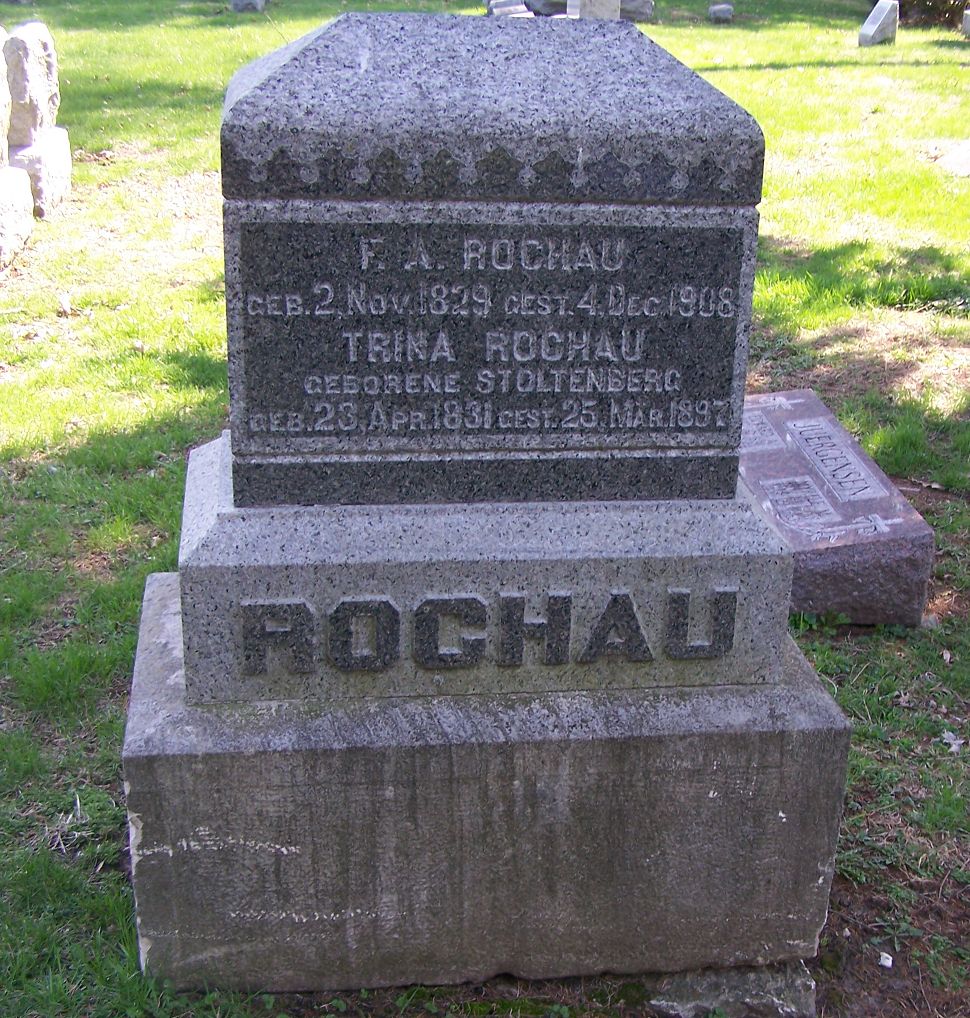
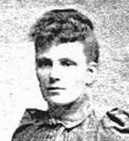 Emma Rochau was born on 28 April 1863, the daughter of Frederick August Rochan and Trina Stoltenberg, in Scott county, Iowa.
Emma Rochau was born on 28 April 1863, the daughter of Frederick August Rochan and Trina Stoltenberg, in Scott county, Iowa.
Emma was married, first, to Thomas Joens on 28 November 1880. Thomas Joens was born on 4 October 1858 in Holstein, Germany. Note that a descendent of Ernest Dengler's older brother, Henry, also married into the Joens family. Emma had five children with Thomas, Albert, Hulda, Arthur, Thomas and Alma.
Emma Rochan [sic] Joens, 29, the daughter of Friedrich August Rochan and Trina Stoltenberg, then married Ernst Dengler, a 24 year old farmer, the son of August Dengler and Henrietta Eckhoff, on 16 February 1892. F.A. Rochau gave his consent for the wedding. The couple had six children of their own. I assume Ernest raised all of these children as his own.
Emma died on 16 November 1935, at the age of 72, in Davenport, Scott county, Iowa. Ernst died on 27 November 1959, aged 91.
(23) Edna Dengler (1897)Born 9 May 1897, the daughter of Ernest Dengler (1868) and Emma Rochan (1863). Of Iowa. She married Elmer Offerman (1891).
"Dengler-Offermann Wedding(24) Jeanne Offerman (1925)The marriage of Miss Edna A. Dengler, daughter of Ernst Dengler, a well known retired farmer of Scott county residing on rural route 7, and Elmer Offermann, a prosperous young farmer of near Eldridge, took place as a quiet ceremony of high noon today at the office of Justice of the Peace Phil Daum in this city. The justice officiated. Mr. and Mrs. Dengler, parents of the bride, were the attending witnesses. The bridal couple will reside on the groom's farm near Eldridge." - from the "Quad-City Times" of Davenport, Iowa
Born 17 March 1925, the daughter of Elmer Offerman (1891) and Edna Dengler (1897). Of Davenport, Iowa. She married Darrell Hissem (1924). Jeanne died in 2001 and her ashes were spread over Four Peaks mountain by her husband and son, flying the family Citabria aircraft.
(25) Georgia Jean Hissem (1948)She married Charles T. Mulhern (1956).
(26) Kerry Jean-Marie MulhernShe married Austin Farris on 8 April 2011.
(27) Addison FarrisThis is the descent of Anita's maternal line. It is a difficult line to trace because, in addition to her mother being unwilling to talk about her family, her grandfather was an orphan and her great-grandmother was the daughter of a man unknown. As significant for an Irish family, however, is that the Public Record Office of Ireland, which held the majority of administrative records for Ireland from the 14th century on, was destroyed during a civil war battle in 1922. Additionally, census records for 1861 through 1891 were destroyed by government order, perhaps simply because there was not room to store them.
Anita Lee Montague's mtDNA ProfileA better source of ancestral information in this case is DNA. Mitochondrial DNA (MtDNA) tracks the female descent, just as Y-DNA tracks that for the male line. However, whereas Y-DNA starts its nomenclature with haplogroup A, in MtDNA we begin with L; I don't know why. The most recent common ancestor in the human female line, the mitochondrial Eve, was the originater of haplogroup L. She was not the first woman, but she is the mother of us all because the female descent of all of her contemporaries died out before today. She lived about 160,000 years ago in East Africa, perhaps more specifically in today's Tanzania. L is still the most common haplogroup in sub-Saharan Africa.
Haplogroup L has seven subclades, L0-L6, of which L3 denotes the out-of-Africa movement. The descendents of L were M and N, which encompass all non-African haplogroups. From M evolved C, Z, D, E, G, and Q. From N evolved O, A, S, R, I, W, X, and Y. From R evolved B, F, H, V, J, T, P, K, and U.

My wife's mtDNA haplogroup is U5b2c2.
U is thought to have originated in the Near East or Southwest Asia about 50,000 years ago. There are nine daughter groups, U1 through U9, indicating a period of rapid population growth.
U5 probably entered Europe before the Last Glacial Maximum. It is found throughout Europe, and almost exclusively in Europe, with an average frequency today ranging from 5% to 12%. Based on unique mutations that distinguish this subclade, researchers have concluded that U5 experienced a long period of very slow population growth or a population bottleneck. This is consistent with a population collapse during the glacial maximum. U5 appears to have been the dominant maternal lineage among the Paleolithic and Mesolithic hunter-gatherers of Europe. More than half of the Mesolithic European mtDNA tested to date belonged to this group.
U5b has a wide distribution, but is most common in northern Spain, with high frequencies amongst the Basque, Cantabrians, and Catalans. Matrilinial lineages amongst modern Basque and Cantabrian populations are almost exclusively U5b. It is also found in high frequencies amongst the Bretons of Brittany. All of the ancient U5 mtDNA samples, including those from Neolithic sites, taken in France and Iberia whose subclade could be identified belonged to U5b - from Eupedia.com. U5b most likely first arose in Europe, in the southern refugium in Iberia alongside the Y-DNA haplogroups I1, I2, and R1b. Its distribution, and the age of the haplogroup, indicate individuals from this haplogroup were part of the initial population expansion following the glacial retreat around 10.000 years ago.
U5b2 developed in Europe during the late-Paleolithic/Mesolithic period.
U5b2c is found exclusively in western Europe.
U5b2c1 is found in the British Isles, France, Germany and Mesolithic Spain [at La-Brana-Arintero]. The sample taken in northern Spain was dated to circa 8,000 years ago.
U5b2c2 is found in the British Isles, France, Germany and Scandinavia. "It seems likely that U5b2c had its origins in an Iberian or Franco-Cantabrian ice age refuge and arrived in the British Isles at a very early date, based on its frequency and diversity in Ireland." - from Familytreedna.com.
The Paleolithic hunter-gatherer population was largely replaced in Europe by Neolithic immigrants who began to arrive about 8,000 years ago. They brought the new farming technology of the Middle East with them. While some of the native population loss may have been due to warfare, in the end, the farmers simply out-competed their neighbors. The haplogroup U5 females that remained were probably absorbed into the immigrant communities.
About 16% of Ireland's population are the product of the original hunter-gatherer population; mtDNA groups U4, U5 and U8. The vast majority, 77%, are from the Neolithic invaders who entered Europe beginning about 5,000 years ago; groups H, J, K, T2, V and X. A small percentage, about 7%, are descendants of the Bronze Age to Viking period; groups I and T1.
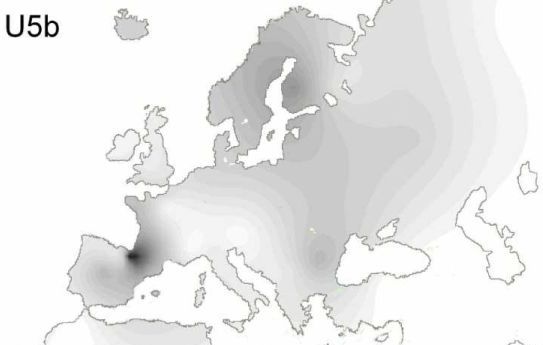
My wife's line is mainly Irish and begins with the immigrant, Anna Dorsey.
(22) Anna Dorsey (c1820)Anita's GGG-Grandmother. Per her daughter's record in the 1930 census, Anna was born and probably lived her entire life in Northern Ireland. Note that the Irish Republic was established in 1923, after a 7-year civil war, leaving the counties of Ulster as the British dependancy of Northern Ireland. However, it appears that the majority of Dorsey households in the mid-19th century were in the middle of the island.
 Anna's youth was probably not a carefree one. The common people, especially the Catholics, were quite poor and child labor common. In the 19th century, the only industry in Ireland were textile mills, which were concentratd in the north. As a child, Anna may have been employed in the mills. If not employed there, Anna would still have had a job at home, producing some craft goods for sale. If the Dorsey family had a farm, it would have been very small. In both law and custom, lands were subdivided equally between male heirs, resulting over time in holdings so small that only one crop, potatoes, could be grown in sufficient amounts to feed a family. If the family rented their land, it was from an absentee landlord, and poorly managed.
Anna's youth was probably not a carefree one. The common people, especially the Catholics, were quite poor and child labor common. In the 19th century, the only industry in Ireland were textile mills, which were concentratd in the north. As a child, Anna may have been employed in the mills. If not employed there, Anna would still have had a job at home, producing some craft goods for sale. If the Dorsey family had a farm, it would have been very small. In both law and custom, lands were subdivided equally between male heirs, resulting over time in holdings so small that only one crop, potatoes, could be grown in sufficient amounts to feed a family. If the family rented their land, it was from an absentee landlord, and poorly managed.
The family probably spoke Gaelic. Today English is spoken throughout the country and the native Gaelic is disappearing. Many Gaelic speakers died in the Great Famine of the 1840s, and Gaelic was replaced by English, which was needed to achieve social mobility. Gaelic still carries a stigma as the language of the poor.
| Dorsey
Or Dorsy. A small village in county Armagh, Northern Ireland, just east of Cullyhanna, near the county's southern border with the Republic of Ireland. The town's name is from the Irish, Na Doirse, meaning "the gateways." The latter refers to an extensive earthwork that runs through southern Armagh, said to have been a rampart for the ancient kingdom of Ulster (circa 100 BC). There is also a Dorsey river that flows through the region. The family's name could derive from any of these features. I do not believe they descend from the Norman D'Arcy family of England as so many Darcys and Dorseys like to claim. Surname variations include Dorcey, Dorcy, Darsey, Darcy, Dawsey and Dossey. |
Marriage customs were very conservative in Ireland and the union was often negotiated by a marriage broker.
Anna Dorsey married a Plunkett, first name unknown - from the death certificate of her daughter, Roseanne Plunkett Sullivvan. He was perhaps of county Down, which is just east of county Armagh. There was a Plunket family recorded there in 1825. Coincidently, there is a church in Dorsey call the Church of St. Oliver Plunkett. Oliver Plunkett was the Archbishop of Armagh in the latter part of the 17th century. He was executed for his purported support of the "Popish Plot." He was made a saint in 1920. The church dates from 1956.
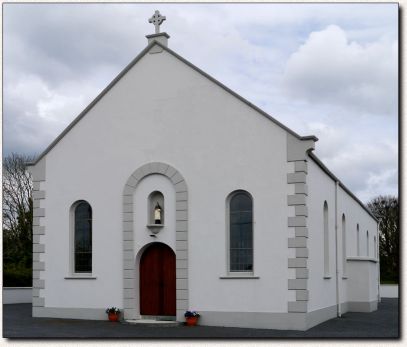
Anna had a daughter named Rose Anna or Roseanne, born in 1851 - from the Ohio death record of Roseanne Plunkett Sullivan.
These were hard times in Ireland. The period from 1845 to 1852 was one of mass starvation, disease, and emigration due to the infamous Potato Famine, the an Gorta Mor. One million people died and another two million emigrated, desperate to escape the country's calamity. Almost 16% of Ulster's population was lost in the famine. The hardest hit were in the southwest of Ulster where 42% of county Cavan, 29% of county Fermanagh, and 28% of county of Monaghan died. Counties Tyrone, Antrim and Armagh lost about 15%. The Plunkett family survived, but there were probably children of theirs that did not.
| Irish Immigration to America
The early Irish immigration to America had been done primarily by the Protestants. It was only in the early decades of the 19th century that the flow turned into a Catholic one. "The Ireland these emigrants left behind was characterized by a rapidly expanding population, land scarcity, economic crisis, and widespread poverty. Between 1815 and 1845, well over 1 million Irish men, women, and children left Ireland, with a considerable number landing in New York. Inducements to emigrate also originated on the other side of the Atlantic, as letters sent home by emigrants and the money they contained were crucial to financing the passage of others." - from "Irish Immigration to New York City"The Irish who emigrated to the United States during the Great Famine represented the largest mass migration in the 19th century. In the years after the famine more Irish women than men emigrated. |
Anita's GG-Grandmother. She was born on 24 December 1851 in Northern Ireland, the daughter of an unnamed Plunkett and Anna 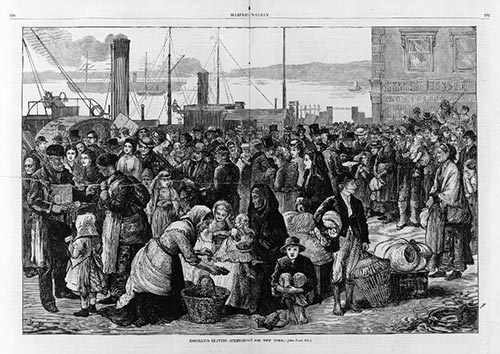 Dorsey, both of Northern Ireland. However, note that over the years Rose was uncertain about her age. In the 1900 census she was 51 with a birth month of December 1848. In the 1920 census she was 67, or born in 1853. In the 1930 census she was 79, or born in 1851, and she said she was married at the age of 19, or born in 1852. She died on 13 December 1930, just before her birthday, at the age of 78, or born, again, in 1851. My guess is that the age given closest to the event is probably the most accurate, so I suspect that Rose was born a little earlier than 1851.
Dorsey, both of Northern Ireland. However, note that over the years Rose was uncertain about her age. In the 1900 census she was 51 with a birth month of December 1848. In the 1920 census she was 67, or born in 1853. In the 1930 census she was 79, or born in 1851, and she said she was married at the age of 19, or born in 1852. She died on 13 December 1930, just before her birthday, at the age of 78, or born, again, in 1851. My guess is that the age given closest to the event is probably the most accurate, so I suspect that Rose was born a little earlier than 1851.
Rose' youth would have been difficult, if not terrifying. The Great Famine lasted through 1852 and the dislocation it caused would have affected the economy for years to come. I expect many of her siblings succumbed in these years. Her prospects, for employment or marriage, were blighted [much like the potato]. As with earlier mass migrations, the best of the population were those who left. They clearly saw the limitations of their current situation and had the energy to do something about it. The comfortable had no reason to leave, and the blind or lazy simply accepted their fate. At right are Irish emigrants of 1874.
Rose emigrated to America in 1871 [the 1930 census says 1870]. The ships of the era were generally sailed powered, with a steam engine provided for limited operations; there was not enough room for coal to power the ship all the way across the Atlantic. The shipping lines, who sought to maximise profits, crammed as many people onboard as they could. Living conditions in steerage were spartan and, combined with the prevalent sea-sickness, could be quite bad.
I have a Roseanna Plunket, 24 [she would have been 19 to 23], who arrived in New York City in September 1871 onboard the SS (steam ship) ASSYRIA, William Smith master, via steerage. Roseanna was on the passenger list for those who embarked at Londonderry on 7 September. Londonderry is a port on the northern tip of Ireland. The SS ASSYRIA, of the Anchor Line, was a single funnel steamship which was also rigged with 3 masts. She arrived in New York City on 19 September 1871 from Glasgow, Scotland. The ASSYRIA was a new ship, launched that year, and carried 100 1st class and 500 steerage passengers.
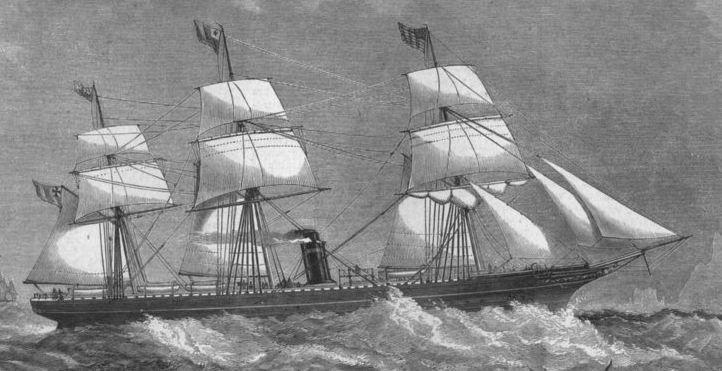
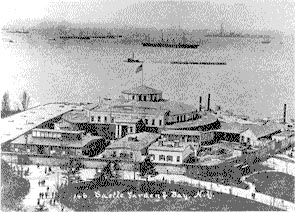 During the period from 1855 to 1890, immigrants coming into New York City were processed at Castle Garden, left, also known as Castle Clinton. This was an old red sandstone fort, built to defend the city during the War of 1812. It was located within the Battery, on the tip of Manhattan.
During the period from 1855 to 1890, immigrants coming into New York City were processed at Castle Garden, left, also known as Castle Clinton. This was an old red sandstone fort, built to defend the city during the War of 1812. It was located within the Battery, on the tip of Manhattan.
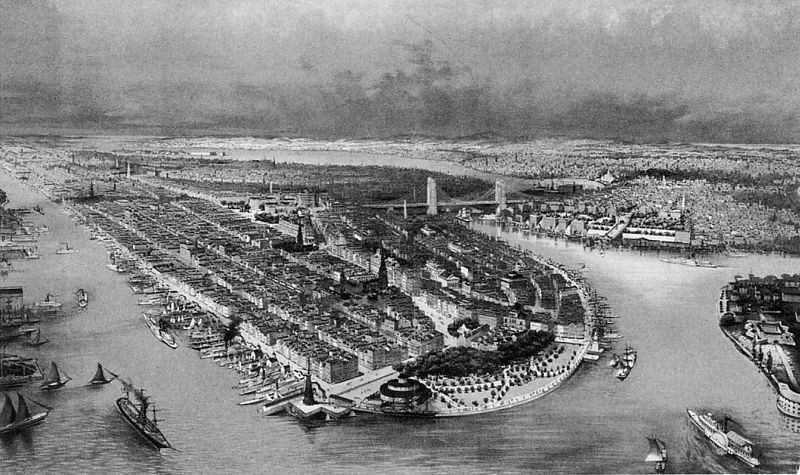
"On August 3, 1855, Castle Garden, under lease to the State of New York, was opened as an immigrant landing depot. Fenced off from the rest of the Battery, the bewildered immigrants were protected from the unsavory characters who had roamed the open wharves at will to take advantage of gullible newcomers. Here the immigrants could obtain information about housing, directions, and fares. Needed medical attention and an honest currency exchange were provided, and information about job oportunities. For 34 years, between 1855 and 1889, it served as an immigration depot, ushering in more than 8 million immigrants to the United States." - from "The Immigrant"The new immigrants could purchase railroad and riverboat tickets at Castle Garden and obtain advice from representatives of religious and benevolent societies.
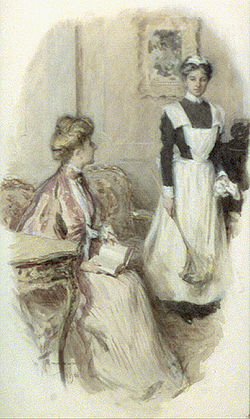 Rose probably found a place to stay and a job through the local Catholic priest. Domestic service was the single biggest form of employment for single Irish women during this period; think of all the Irish maids that the Clarence Day family went through in the movie, "Life with Father." Unlike other nationalities emigrating to America at this time, Irish women saw no social stigma in service nor were their families concerned about their daughters living away from home. The young women traveled to America alone for the most part and were long used to serving in an economic capacity at home. As a domestic, Rose may even have lived at her employer's home, saving her more money. The other employment opportunity was the "needle trade;" seamstresses, milliners, dressmakers, shirt and collar makers, embroiderers, and pieceworkers in the new factories and sweatshops. This line of work did not pay as well as domestic service and the working conditions were often shockingly poor.
Rose probably found a place to stay and a job through the local Catholic priest. Domestic service was the single biggest form of employment for single Irish women during this period; think of all the Irish maids that the Clarence Day family went through in the movie, "Life with Father." Unlike other nationalities emigrating to America at this time, Irish women saw no social stigma in service nor were their families concerned about their daughters living away from home. The young women traveled to America alone for the most part and were long used to serving in an economic capacity at home. As a domestic, Rose may even have lived at her employer's home, saving her more money. The other employment opportunity was the "needle trade;" seamstresses, milliners, dressmakers, shirt and collar makers, embroiderers, and pieceworkers in the new factories and sweatshops. This line of work did not pay as well as domestic service and the working conditions were often shockingly poor.
The new Irish immigrants felt a strong connection to the Catholic church, it was an integral part of their ethnic identity, and supported their local parishes in the city. However, they did not necessarily attend Mass regularly. The church was a social center of their lives and all of the churches held "socials" at which unmarried men and women were introduced to each other.
Rose Plunkett married James Sullivan in America in about 1871; there are no marriage records. James was born on 17 May 1853 [or 1852 per the 1861 census, or 1851 per the 1900 census] in Wales, the son of Robert Sullivan and Honora Harrington, both of Ireland - from his death record.
In the 1861 census of Abergavenny, Monmouthshire, England as Robert Sullivan, a 35 year old general laborer, of Ireland, living on Tudor street. Living with him were his wife, Honora, 32, of Ireland, and children, Honora, 12, of Ireland, James, 9, of Gloucestershire, and Richard, 5 months, of Monmouthshire. Gloucestershire, where James was born, was in England, not Wales. I think the confusion may be that James grew up in Monmouthshire, which is in southeastern Wales, just west of Gloucestershire. Note that the Sullivans left Ireland no earlier than 1849, though I haven't found them in the 1851 census.
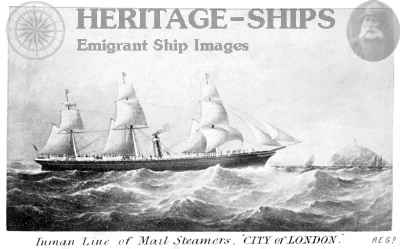 James had emigrated to America in 1870, when he was 17-19 years old. The picture of the CITY OF LONDON, right, was typical of the emigrant ships of the period. By the way, these are often termed "coffin ships" for the number of those that foundered on the way across. However, it should be noted that the early technology did the best as it could in opposition to violent weather, icebergs, and uncharted shoals. No ship's master lost his ship, and his life, willingly.
James had emigrated to America in 1870, when he was 17-19 years old. The picture of the CITY OF LONDON, right, was typical of the emigrant ships of the period. By the way, these are often termed "coffin ships" for the number of those that foundered on the way across. However, it should be noted that the early technology did the best as it could in opposition to violent weather, icebergs, and uncharted shoals. No ship's master lost his ship, and his life, willingly.
As you might imagine, there were a plethora of James Sullivans who arrived in America in 1870, but only two with a birth in Wales or Great Britain, under which Wales was subsumed.
- Jas. A. Sullivan, a 19 year old laborer, of Great Britain, arrived in New York City from Liverpool on 16 April 1870 onboard the SS CITY OF LONDON, Henry Tibbets master, via steerage. The ship has 1,120 passengers onboard.
- James O. Sullivan, an 18 year old laborer, of Great Britain, arrived in New York City from Liverpool and Queenstown [Ireland] on 27 June 1870 onboard the SS IDAHO, James Price master, via steerage.
Irish women rarely worked outside the home after marriage, though there was more than enough to do in the home. Just as in Ireland, most poor women did some kind of needlework to supplement the family's income. Others took in laundry or, as we know from "A Tree Grows in Brooklyn," worked as scrubwomen.
I don't know where Rose and James met or where they married; certainly the marriage occurred very soon after Rose arrived. I will guess that both stayed in New York City for a time, getting their feet under them and figuring out where in this huge country they should eventually settle. Five Points was an Irish slum in the Sixth Ward of lower Manhattan, not far from Castle Garden. At its height, Five Points vied with London's East for population density, disease, infant and child mortality, unemployment, prostitution, violent crime, and other classic ills of the urban decay.
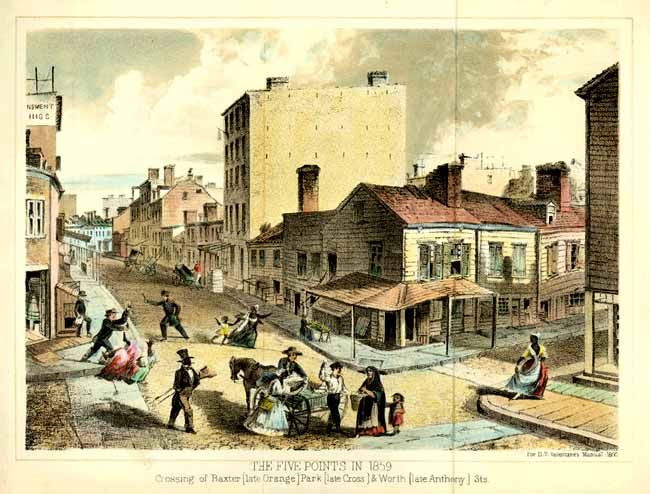
There is from this point a 30 year gap in the couple's story. During this time Rose had eight children, lost five of them, and James became a skilled laborer.
In the 1880 census . . . there is a James Sullivan, 27 [1853], in Mifflin, Allegheny county, Pennsylvania. There is also a James Sullivan, 25 [1855] (a little young), in Pittsburgh, Allegheny county, Pennsylvania. I don't see Rose living with either, however.
In the 1900 census of Allegheny, Ward 3, Allegheny county, Pennsylvania as James Sullivan, a 49 year old puddler worked in a steel plant], born in May 1851, of Wales, and his wife, Rosana Sullivan, 51, born in December 1848, of Ireland. They lived at 823 Pike Street, which was in the southeast corner of the ward. James had emigrated in 1870 and was now a naturalized citizen. Rose had emigrated in 1871. James could read and write, but Rosana could not. They had been married for 29 years, which means they had wed the same year Rose arrived in America. She had 8 children, of which 3 were still living. Living with them were daughters, Nelly, 14, born in May 1886, and Alice, 7, born in December 1893, both of Pennsylvania.
James and Rose' other daughter, Rose, had married in 1899, though I haven't found her or her new husband, Charles Gormly, in the census.
| The Iron Puddler
"Bars of charcoal iron were heated in a furnace by an indirect coal fire. As the bars melted, a "puddler" (also called a rabbler) stirred the liquid. Impurities (mainly phosphorous, silica, and carbon) burned off and the puddled iron formed pasty balls. The puddler would rake these iron balls together to form a large lump weighing a few hundred pounds. When all of the puddled iron balls had formed and joined to the large lump, the puddler would declare that the iron it had "come to nature" (decarburized.)" - from the Appalachian Blacksmiths AssociationWorking as a two man crew, a puddler and helper could produce about 1500 kg of iron in a 12-hour shift. The strenuous labor, heat and fumes caused puddlers to have a very short life expectancy, with most dying in their 30s. Puddling was never able to be automated because the puddler had to sense when the balls had "come to nature." - from Wikipedia |
In the 1910 census of Cleveland, Ward 6, Cuyahoga county Ohio as James Sullivan, a 56 year old patient in the Cleveland City Hospital. There was no indication of his illness. I haven't found anything for his family. Note that, like Pittsburgh, Cleveland had a large steel industry which would have attracted a skilled "puddler."
James Sullivan, a 57 year old Iron Worker, born 17 May 1853 in Wales, the son of Robert Sullivan and Honora Harrington, both of Ireland, died of pulmonary tuberculosis on 30 October 1910 at City Hospital, in Cleveland, Ohio. He was buried on 1 November in the Calvary cemetery. All of this information was provided by Mrs. Ted Royston [James' daughter, Rose]. - from Ohio Deaths, 1908-1953.
In the 1920 census of Cleveland, Cuyahoga county, Ohio as Rosana Sullivan, 67, of Ireland. She was living with her daughter, Alice, 28, and son-in-law, William R. Duff, 50.
In the 1930 census of Cleveland, Cuyahoga county, Ohio as Rose A. Sullivan, a 79 year old widow, born in Northern Ireland. Her parents were also from Northern Ireland. She emigrated in 1870. Her age at her first marriage was 19. She was able to read and write . . . did she learn since 1900 or was one of these entries a mistake? She was living with her daughter, Nellie, and her husband, Walter A. Delong.
Roseanne Sullivan, the daughter of Anna Dorsey and [Unknown] Plunkett, the 78 year old widow of James Sullivan, born 24 December 1851, in Ireland, died on 13 December 1930 in Cleveland, Ohio and was buried in the Calvary cemetery on 16 December 1930. She resided at 4143 E. 81st street. - from Ohio Deaths, 1908-1953.
Their surviving children were,
(24) Rose Sullivan (1877)
(24) Nelly Sullivan (1886)
(24) Alice Sullivan (1893)
Anita's G-Grandmother. She was born on 25 December 1877 in Pittsburgh, Pennsylvania - from her death record.
Rose first married in 1899.
"Rose Sullivan, born in Allegheny county, Pennsylvania on 25 December 1876 [sic], residing at 30 Voegtly street, Allegheny, PennsylvaniaThe neighborhood in the vicinity of Voegtly, pronounced FECKly, street was known as the Schweizer Loch, or Swiss Hole, because it was originally settled by Swiss emigrants and for its lowland location.
married
Charles Gormly, born in Pittsburgh, Pennsylvania on 13 November 1875, residing at 305 Ferry street, in Pittsburgh, salesman.
on 10 April 1899, by Justice Groetzinger Ald[erman]" - from Pennsylvania County Marriages, 1885-1950" in familysearch.org
| Allegheny City
In 1900 Allegheny City was the third largest city in the state of Pennsylvania. It was located on the north side of the junction of the Allegheny and Ohio rivers, across from downtown Pittsburgh. It was annexed by Pittsburgh in 1907. 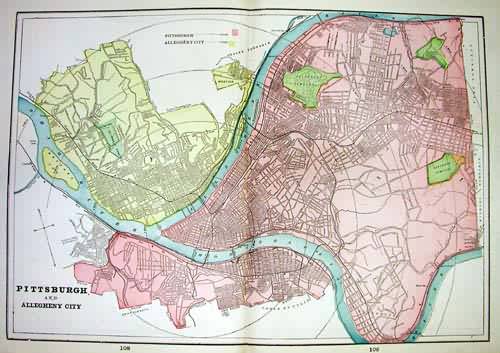 Allegheny City in yellow / Pittsburgh in red Allegheny City was an industrial zone of packing houses, tannerries, soap factories and glue factories. The H.J.Heinz company built its factory in Allegheny City. - from Wikipedia. 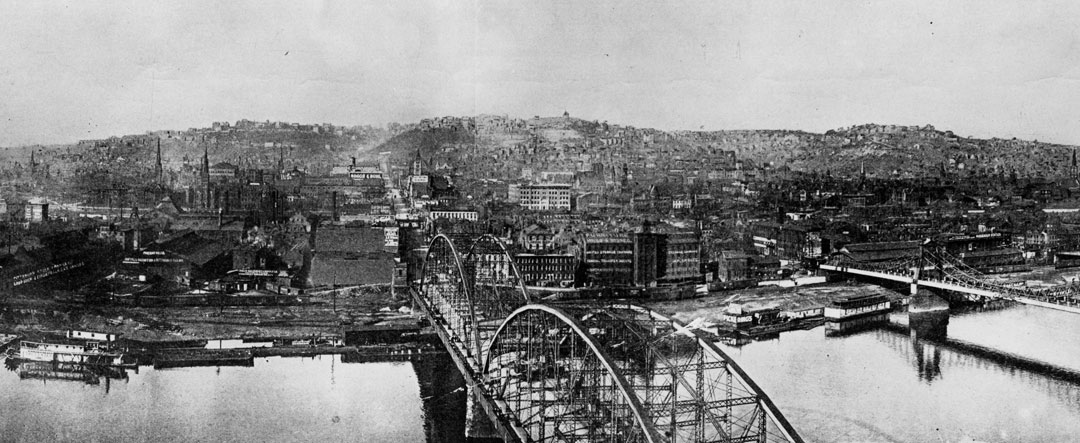
|
In the 1900 census . . .
Rose moved to the Cleveland, Ohio area before 1902; Rose' parents would move there prior to 1910. I haven't yet found any evidence of a death or divorce, but Rose married again in 1902.
Rose Sullivan, 25, the daughter of Jas. Sullivan and Rose Ann Plunket, married Terence Royston, 31, the son of Edward Royston and Helen Durrans, on 17 September 1902 in Cuyahoga county, Ohio - from Ohio, County Marriages, 1789-1997Terrence Edward Royston was born on 2 July 1871. His birth was listed as in "other country" [England] - per the California Death Records. Family lore claims that, a musician, he played before Royalty while he lived in England. Didn't everyone? He emigrated to America sometime between 1887 and 1896, depending on which census you believe. The latter is probably closer to the mark and would make him 25 years old at the time he arrived.
In the 1910 census of Cleveland, Cuyahoga county, Ohio as Terrence Royston [Timme in Ancestry.com], a 38 year old [1872] musician in a theater. I suspect this was a musical theater. He had emigrated from England in 1887 [1889?]. Living with him was his wife, Rose A., 32 [1878], at 4280 East 96th street. Terrence and Rose had been married for 7 years, but had no children. This was shown as Rose's second marriage. She was from Pennsylvania. Her father was Welsh and her mother Irish.
In the 1920 census of Cleveland, Cuyahoga county, Ohio as Terrence Royston, a 42 year old [1878] musician in a cabaret, and his wife, Rose, 48, at 4280 96th street.
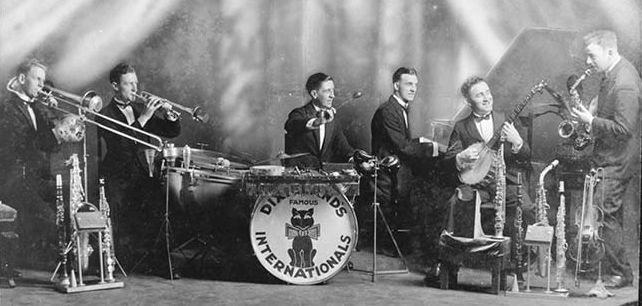
Rose Sullivan Royston, 44, died on 11 March 1922 in Cleveland, Cuyahoga county, Ohio. She and Terence were living at 4118 East 82nd street. She was buried in the Calvary cemetery. Her father was listed as James Sullivan and her mother as Rose Plunk [sic] - from Ohio Deaths, 1908-1953.
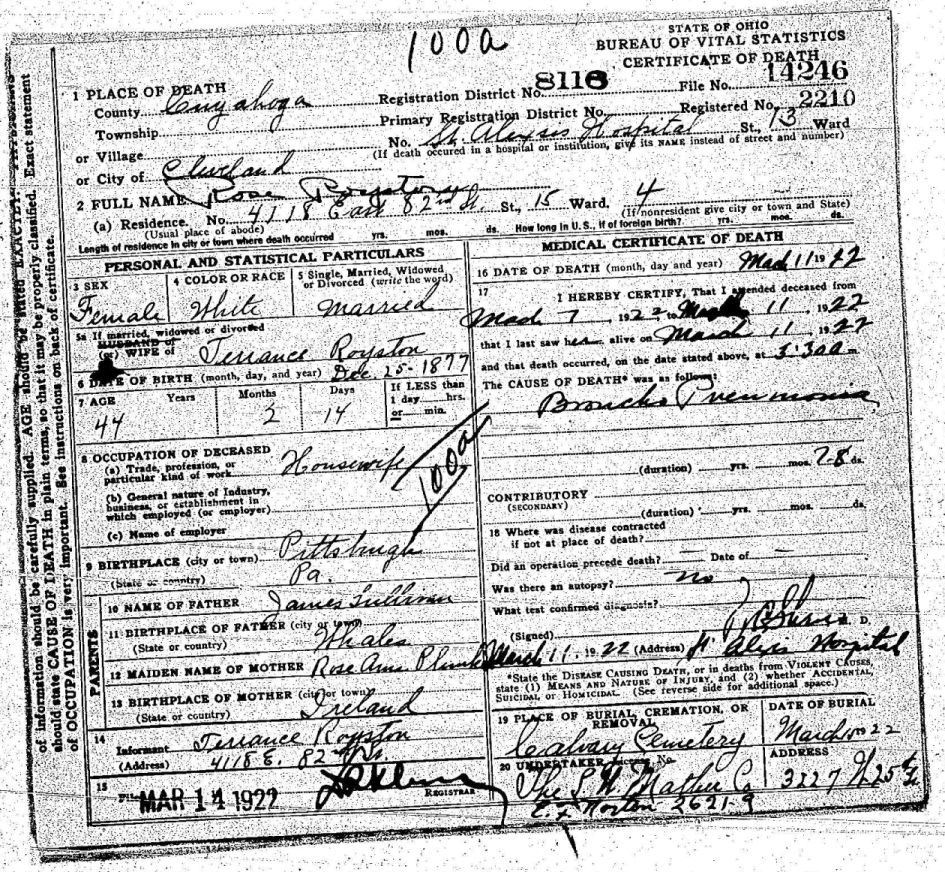
Terrance Royston's daughter, Rose, married George Bassett in about 1927. George had lived in El Cajon, San Diego county, California in 1920, before moving to Ohio where he met and married Rose. George and Rose moved back to San Diego county after 1930, I suspect taking Ted Royston with them.
In the 1930 census . . .
In 1939 Terrence Edward Royston was naturalized while living in San Diego county, California. Seems a little late . . .
"Name: Royston, Terrence Edward
Residing at: 223 Norton Ave., National City, Calif.
Age: 68 years. Date of order of admission: July 19, 1939
Date certificate issued: July 21, 1939 by the
Superior Court of San Diego, Calif.
Petition No.: 6615" - from "Naturalization Index Cards from the Superior Court of San Diego, CA"
In the 1940 census of National City, San Diego county, California as Terrance Royston, a 67 year old widower, of England. He was living with his son-in-law, George F. Bassett, a 32 year old mechanic in a garage, of Idaho, and daughter, Rose F., 29, of Ohio, and grandchildren, Hazel, 11, and Virginia, 9, both of Ohio. There were also a couple of lodgers, Lydia and William Henkle, and George's sister, Eulalia Duff, 16.
Terrence Edward Royston died in San Diego, California on 10 October 1941 - from the California Death Index. His mother's maiden name was Durran.
Terrence and Rose' child was,
(25) Rose F. Royston (1911)
Anita's Grandmother. Rose Royston's birth certificate said that her father's name was Royston, "so the mother says." She called Terrence "Uncle Ted" throughout her life rather than father.
The newer information below was provided by Charlotte, a researcher whose matrilineal line [or that of her husband?] is, at some point, coincident with the line of Rose Royston.
Rose was born on 3 March 1911 in Cleveland, Ohio. Family lore says that Rose was illegitmate, her real father being named Mahill [or Mahale?]. According to my father-in-law, her birth certificate indicated that her father was a camera operater in a theater [Terence was a musician in a theater] and her mother was a waitress. I suspect a couple that were married for 7 years with no children, like Terence and Rose, were probably unable to conceive. I suspect that our Rose was the child of a man who became known to Terence because they both worked at the same theater. Terence and Rose adopted this child, resolving their problem and that of the camera operator. If this scenario is true, then we don't know the identity of Rose's mother either. However, the family believes that Rose Sullivan had an affair that resulted in little Rose.
In the 1920 census of Cleveland, Cuyahoga county, Ohio as Rose Royston, 8, of Ohio. She was living with Terrence and Rose Royston at 4280 96th street.
Rose Royston married George F. Bassett Jr. in about 1927 when she was only 16. He was a orphan [another dead end!]. George F. Bassett was born on 4 April 1907. See the Bessette/Bassett Family, below, for the ancestry of his adopted father. Note that George's adoptive father had been, at the time of the 1900 census, a saloon keeper living in Council, Washington county, Idaho. He remained in that area, moving between the towns of Council, Decorah, Weiser, Twin Falls and Shoshone Falls, between 1900 and 1909. This was probably the region in which George Jr. was born and adopted.
In the 1910 census of Salt Lake City, Utah as Geo Bassett Jr., 3, of Idaho. He was living with his adoptive parents, Geo Bassett, a 49 year old saloon proprietor, Hazel, 34, and a sister, Alice, 7, of Montana. The children were listed as being Hazel's own. There is, in fact, no indication that George was adopted, except, tangently, in the 1930 census, below.
In the 1920 census of El Cajon, San Diego county, California as George F. Bassett, 12 [1908], born in Idaho. He was living with George and Hazel Bassett. Also living with them were Alice, 16, of Montana, and George Sr.'s brother, Eugene [Engane in Ancestry.com], 40, of Wisconsin.
George Bassett moved to Ohio to find work and there met and married Rose Sullivan Royston. Below is the background of George F. Bassett Jr's adoptive parents' family.
| The Bessette/Bassett Family
Besset family researchers have confirmed, via DNA testing, that Israel Bassett of Fond du Loc, Wisconsin, below, was a member of the Jean Besset family of France. (18) Jean Bessette (1642)Jean was born in about 1642 in Cahors, in the Midi-Pyrenees, in Guyenne, France. In the year 1665 Jean was a member of The Carignan Regiment, which was comprised of four companies of fifty-man each. They left the port of LaRochelle, France for Quebec in that year. Jean was a member of the Carignan-Salieres Regiment, sent to protect the French settlers of the young colony from the Iroquois Indians. The trip took three months. While on board the sailors & soldiers gave each other what we call nicknames. They gave Jean the name of "Brisetout" which means "The Wrecker". I would assume Jean liked the name as he used it for the rest of his life. Jean married Anne LeSeigneur on 3 July 1668. She was born on 1 March 1649 in St-Maclou, V. Et Archev. Rouen, Normandie, France, the daughter of Guillaume Seigneur and Madeleine Sauve/Serre. She was amongst some seven hundred women who had been sent to New France in hopes they would marry the soldiers and populate the new country. They were known as the "King's daughters." After his service as a soldier was complete, sometime around 1673, he took up farming in the Chambly region. Jean died on 5 January 1707 ub Chambly, Quebec, Canada. Anne died 4 July 1733 in Chambly, Quebec, Canada. (19) Jean Bessette Jr. (1672)(18) Jean Bessette (1642) He was born on 27 December 1672 in Chambly, Quebec, Canada. In 1691 Jean Besset was surprised by Indians and was scalped, but lived. His first wife was Marie Anne Benoit, a widow. They were married on 16 May 16 1695. She died of wounds received while defending herself from an Iroquois Indian who was tying to take her captive in August 1697. One child was born to them, Marie-Jeanne Besset.
Jean then married Madeleine Plamondon in Chambly, Quebec on 27 September 1700. Jean and Madeleine had nine children,
Jean died on 18 May 1751 in St. Mathias, Quebec. (19) Francois Bessette (1685)(18) Jean Bessette (1642) The younger brother of Jean Jr., he was born on 26 July 1685 in Contrecoeur, Quebec. He married Marie Claude Dubois, the daughter of Antoine Dubois and Marie Cantin on 9 February 1716 in Chambly. He died on 3 June 1764 in Chambly, Quebec. (20) Clement Besset (1728)(18) Jean Bessette (1642) (19) Francois Bessette (1685) He was born in 1728 in Chambly, Quebec. He married M-Charlotte Lamoureux. He died on 22 August 1789 in St. Mathias, Quebec. (21) Olivier Bessett (1771)(18) Jean Bessette (1642) (19) Francois Bessette (1685) (20) Clement Besset (1728) He was born on 27 January 1771 in Chambly, Quebec. He married Marie-Catherine Masse. He died on 14 April 1843 in Marieville. (22) Francois-Xavier Bessette (1808)(18) Jean Bessette (1642) (19) Francois Bessette (1685) (20) Clement Besset (1728) (21) Olivier Bessett (1771) He was born on 29 January 1808 in Marieville, Quebec. He married Sophie Robert on 22 January 1833 in Marieville. She was the daughter of Jean-Francois-Regis Robert and Marguerite Baudry. Their children included, Julie, Philomene, Marguerite, Praxede, Israel, Louis-Cyrille, Sophie, and Francis-Xavier. Francois died in about 1847. Sophie died at about the same time and the younger children were raised by relatives. (23) Israel Bassett (1837)(18) Jean Bessette (1642) (19) Francois Bessette (1685) (20) Clement Besset (1728) (21) Olivier Bessett (1771) (22) Francois-Xavier Bessette (1808) His surname may be Bessette. He was born in Montreal, Canada of French descent. He married Julia Snow. In the 1870 census of Fond du Lac, Wisconsin as Israel Bassett, a 33 year old Harness Master, from Canada. Living with him were his wife, Julia, 26, of Wisconsin, and his children, George, 7, Frank, 5, Emma, 3, Fred, 2, and John, 1 [?]. In the 1880 census as Israil Bassett, a 42 year old harness maker. Living with him were his wife, Julia, 36, and children, Jersey, a 17 year old harness maker [our George?], Frank, 15, Emma, 13, Fred, 12, Isadore, 9, Sophia, 7, Ida, 5, and Clara, 3. Another son, Eugene, would be born in 1880. I don't see him in the 1900 census. In the 1910 census of Fond du Lac, a 74 year old widower living with his daughter, Mary Strong. He also had a son, Isadore, who lived nearby. (24) George Israel Bassett (1863)(18) Jean Bessette (1642) (19) Francois Bessette (1685) (20) Clement Besset (1728) (21) Olivier Bessett (1771) (22) Francois-Xavier Bessette (1808) (23) Israel Bassett (1837) He was born on 21 January 1863 in Wisconsin. In the 1870 census of Fond du Lac, Wisconsin as George Basset, 7. In the 1880 census of Fond du Lac as Jersey Bassett, a 17 year old harness maker. Is Jersey a nickname for George? George married Hazel in about 1897. She was from Missouri. In the 1900 census of Council, Washington county, Idaho as George Bassett. This county is in the west-central part of the state, on the border with Oregon. This man was the right age, from Wisconsin, and a saloon keeper, a job he also practiced in Salt Lake City, below, but he was shown as single and born in May 1863 [perhaps everyone who heads out west is "single"]. This "might" be our man if we assume he left his wife someplace for a time. He had many servants living with him at his residence who were workers in the saloon. They included two day laborers, a musician, a Norwegian bartender, a table master [ran the roulette wheel?], and a waiter d' Hotel. The last was the only woman. Her name was Hazel Jones, a 22 year old [March 1878] married woman, of Pennsylvania. Could this be George's wife? Her given name was Hazel afterall. "Liquor licenses [granted]: Deaver & Norman, F.J. Beale, George Bassett, Payne & Wannemaker, Jewell and Camp = Council" - from the Salubria Citizen newspaper, 19 January 1900The town of Council began to boom with the arrival of the P.&I.N. (Pacific and Idaho Northern) railroad in 1898. Ore from the copper mines in the nearby Seven Devils mountains, which had previously been hauled overland to the county seat at Weiser, was now loaded onto rail cars in Council. For a time the town was "wide open" and almost as wild and wooly as any early day mining camp. There were six saloons, in all of which gambling games were run, and there were also bawdy houses, all of which ran day and night. "Another shooting in Council. Chas. Bowman came off a two day drunk to discover he had no money. He went to Bassett's saloon and demanded his money. On being refused, he left, got a gun, came back and leveled it at the bartender. "Just at that juncture the bartender had business behind the bar in the region of the floor,..." Mr. Bassett, the owner of the saloon, came in and Bowman turned the gun on him. Bassett shot Bowman in the elbow and stomach. Dr. Loder was called - amputated the shattered arm. Bowman died Wednesday." - from the Cambridge Citizen newspaper, 22 June 1900Another reference to the same incident, "Council has the credit of pulling off two homicides during these stirring times. The first, I believe was the killing of Sam Harpham, generally known as "Hardpan", who was shot and killed by a man by the name of Moore. The other killing was of a tough stranger by George Basset, a proprietor of one of the Bawdy houses, with saloon and restaurant connected. George was as peaceable and quiet a person as to be found in the town until stirred up and then he was bad, as the tough stranger found out, if he lived long enough to realize anything. Inquests were held in these cases with verdicts of justifiable homicide." - from "The History of Washington County, Idaho," by Judge Frank HarrisA Bawdy house is, of course, a brothel. Below is a photograph of Council. 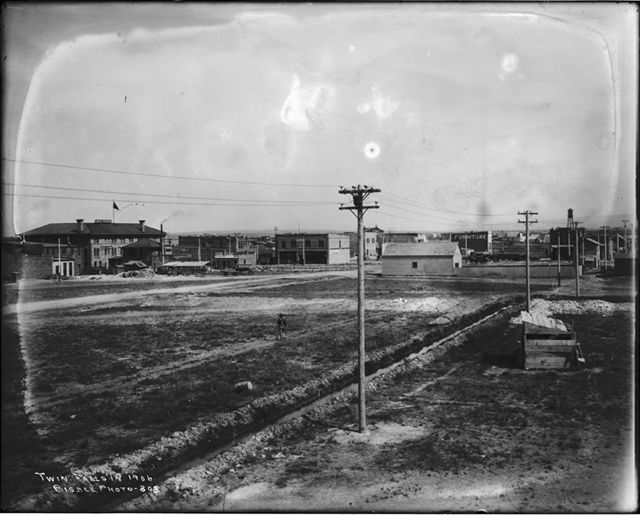 "The back of the Hotel Perrine, at the west corner of Shoshone Street and Main Avenue West, is seen in the early photograph. Obscured from view by the hotel is the Bucket of Blood Saloon, at the east corner of Shoshone Street and Second Avenue East. The saloon was in the rear of the building, which fronted Second Avenue" "The Bucket of Blood saloon, one of the first establishments in town, was operated by George Bassett at the corner of Shoshone Street and Second Avenue East. The saloon was in the rear of a general store, owned by the Young family, that fronted Second Avenue." - from Hidden History: The Bucket of Blood Saloon "Liquor licenses [granted]: Council: R.P. Carter F.J. Beal,, Fleckenstein Mayer Co.,, Geo Bassett,, Addington & Kinser,, J.H. Bolan" "Decorah: Geo Bassett" - both from the Cambridge Citizen newspaper, 26 October 1900Decorah was a mining camp, but is today a ghost town. It was the "fun center" for miners from Landore and Helena. "Bassett later opened a second Headquarters saloon in Decorah. It was the opulent sin palace that Winifred Brown Lindsay remembered seeing when she was a girl, after the saloon had closed down. For those of you who went on our tour Saturday, I have figured out that Decorah really was on the wider flat just around the corner from the sign where we stopped. Bassett's saloon, from Lindsay's description, was on the right (east) side of the road, and had a lawn that extended back to the creek." "Headquarters Saloon - George E. [sic] Bassett prop." - from the Council Journal newspaper, 23 January 1901Note, the Council Journal of 6 April 1901 mentions the ""Headquarters Branch House" Saloon Jas. Gorman, Mang. (a Decorah branch of the Headquarters Saloon in Council)." "The Headquarters Saloon, Decorah - Geo. Bassett, prop." - from the Seven Devils Standard, 7 June 7 1902 "Geo. Basset - former resident of Seven Devils and later of Weiser [the county seat].- now farming near Twin Falls" - from The Weiser Semi-Weeking Standard newspaper, 15 July 1905Well, not exactly farming . . . There was also a Headquarters Saloon and Restaurant in Twin Falls, Idaho at Shoshone Street and Second Avenue East. "The Headquarters -- known to its patrons as the "Bucket of Blood" -- was owned by George Bassett and leased to S.G. Hamburg. As one man said, the building was "not exactly an architectural beauty, but it had its place in the upbuilding of Twin Falls." Later, sentimental old-timers would recall the days when they "trudged through the dust to the Headquarters for their meals." And their booze. Bassett was the first to run afoul of the law. On Feb. 22, 1905, a district judge issued a warrant ordering officers of the court to search the Headquarters for gambling devices operating in violation of the Idaho penal code, and to seize any such devices found. That evening, Deputy Sheriff F.E. Ramsay executed the warrant and took from the saloon's basement a collection of gaming tables, cards and other paraphernalia. The next morning, as ordered by the judge, the impounded materials were piled on a bed of sagebrush and burned in the presence of a large crowd . . . By this time the number of saloons in town had grown to six, and county authorities decided to take action to rein them in . . . On April 13, 1905, while the bar owners awaited trial, Twin Falls was finally incorporated as a village. Six days later, the saloon owners were tried. They all pled guilty, but, since Twin Falls was then incorporated and the five-mile law no longer applied, they were fined only token amounts." - from "Fighting demon rum: Young city struggles to regulate saloon keepers" by James VarleyTwin Falls, Idaho sits on the rim of the Snake River gorge. S. G. Kesl "Purchased Headquarters Saloon and Cafe for $4,000. 6/9/05-7" - from the Twin Falls Weekly News "Jim Mitchel has leased his barber shop to Bassett for one year...." - from The Weiser Semi-Weeking Standard newspaper, 9 June 1906 "Mr. Bassett sold his barber shop to Mr. Reeves" - from The Weiser Semi-Weeking Standard newspaper, 10 October 1906George apparently moved again, this time to Shoshone Falls, on the Snake river, which is not far from Twin Falls. There was a ferry at the site that undoubtedly provided the hotel with the majority of its business. I don't find any evidence of a town. "Shoshone Falls Hotel. George Bassett granted liquor license for hotel. 11/08/07-3." - from The Twin Falls Weekly News newspaperAs usual, George didn't stay at anything long. In January 1909 the man who succeeded George, George McAlister, had sold the hotel again. However George stayed in the region for two more years. George and Hazel had two children, Hazel and George, but they were probably adopted if family legend is to be believed. When they were adopted is unclear, but certainly it was before 1910. George Jr. was born in Idaho, but Alice was born in Montana. How did she get to Idaho to be adopted by George and Hazel? The simplest explanation is that she was born in Montana, but orphaned in Idaho. At some point George and Hazel had realized they could have no children on their own. They probably went to the nearest orphanage hearing that they had a young boy available and, once they got there, they also fell in love with a young girl there and adopted both at the same time. Sometime after this the Bassetts moved to Utah. In the 1910 census of Salt Lake City, Utah as Geo Bassett, a 49 year old saloon proprietor. I wouldn't think there would be that many saloons in Salt Lake City. Living with him were his wife, Hazel, 34 [1876], and children, Alice, 7, of Montana, and Geo Jr., 3, of Idaho. George and Hazel had been married for 13 years. Hazel had 2 children, both still living. There were mining camps in Utah, and concomitant saloons, in the 1860's. In the 1920 census of El Cajon, San Diego county, California as George Bassett, a 58 year old farmer, of Wisconsin. Living with him were his wife, Hazel, 44, of Missouri, and his chidren, Alice, 16, of Montana, George F., 12, of Idaho, and George Sr.'s brother, Eugene, 40, of Wisconsin. George's father was French Canadian and his mother was from Wisconsin. In the 1930 census of San Diego, California as George Bassett, a 69 year old horse trainer at the Jockey Club, of Wisconsin. His father was French Canadian and his mother was from Wisconsin. Living with him was his wife, Hazel B., 57, of Missouri. He had married at the age of 38, she at 23. Note that George's brother, Eugene, moved north to Belvedere, Los Angeles county, married Marie and had two daughters, Ludivine and Eva. He worked in the oil fields. George Israel Basset, mother's maiden name Snow, died in San Diego county on 2 May 1952. (25) Alice Bassett (1904)Of Montana. I know nothing about her after the 1920 census, when she was still living at home in El Cajon, California. (25) George Frank Bassett (1907)According to Lloyd Montague, he was born on 4 April 1907 in Boise, Idaho. |
In the 1930 census of Cleveland, Cuyahoga county, Ohio as George Bassett, a 23 year old with no occupation, and his wife, Rose, 19, at 4118 East 82nd street. They had been married for 3 years. Rose was from Ohio and her parents were from Pennsylvania [not England?]. George was shown as born in about 1907 in Idaho, as were his parents. Before he left home I suppose George had been informed by his parents that he was adopted so he showed the birthplace of his natural parents. Did he assume their birthplace was the same as his own or had his adoptive parents told him this as well? Living with them was a daughter, Hazel, 1. A second daughter, Virginia, would be born later that year.
In the 1940 census of National City, San Diego county, California as George F. Bassett, a 32 year old mechanic in a garage, born in Idaho. Living with him were his wife, Rose F., 29, of Ohio, and children, Hazel, 11, and Virginia, 9, both of Ohio. There were also a couple of lodgers, Lydia and William Henkle, George's father, Terrance Royston, a 67 year old widower, of England, and his sister, Eulalia Duff, 16.
George and Rose divorced after 1940. George had little to do with his family after this. A George F. Bassett, born on 1 January 1907 at an unknown place, died on 20 December 1991 in San Diego. However, this George Bassett got his Social Security number in New Mexico. Does that sound right?
Rose then married John Marvin Gleave. He was born on 11 June 1905 in Omaha, Nebraska.
In the 1930 census of La Mesa, San Diego county, California as John Gleave, a 24 year old ice cream truck driver, of Nebraska, and his wife, Della [Della Belle Pattillo, the daughter of William Graham Pattillo and Theresa May McCarthy], 18, of California. They had been married for a year. John's parents were from England and perhaps he was too.
In the 1940 census of La Mesa, San Diego county, California as John Gleave, a 34 year old chauffeur for a retail lumber company, of Nebraska. Living with him were his daughter, Joan, 8, and mother-in-law, Theresa Kane, a 50 year old widow. Della MaeJoan [Joan] Gleave was born on 12 April 1931 in San Diego. Joan later lived in Lake Tahoe. The census does not indicate that John was either divorced or widowed, but Della was not present. I can't believe that Della's mother [Theresa must have remarried] would continue to live with John Gleave if he had divorced Della. Della apparently next married a man named Ruhnow. A Fred Coleman Ruhnow died on 4 July 1960 and was buried at Fort Rosecrans, San Diego. Della B. Ruhnow, also known as Della Pattillo, then married Phillip M. Garvin in 1962, divorced him in 1974, and died on 1 August 1977 in San Diego.
Rose Sullivan Gleave, father's surname Royston, died on 9 June 1987 in Chula Vista, San Diego county, California. She was buried with John Gleave at the Glen Abbey Memorial Park cemetery, in Bonita, San Diego county, California. John Marvin Gleave died on 10 April 1988 in Chula Vista, San Diego county, California.
Note that (24) William R. Duff, below, had a nephew, (25) Frank Royston, aged 11 [1919], living with him in San Ysidro at the time of the 1930 census. I believe this was another child of Terrence and Rose, though I haven't found evidence of this. Was the use of the word nephew more general? I don't see any other Roystons in San Diego county at the time.
Rose and George had the following children,
(26) Mary Hazel Bassett (1929)
(26) Virginia Bassett (1930)
She married Stanley Noffsinger. My wife has many stories about Uncle Stanley, a jockey who ate himself out of a job. He later parked cars at the track. Note that George Bassett, Mary's Hazel's father, was, in 1930, a horse trainer in San Diego.
(26) Virginia Rose Bassett (1930)Anita's mother. She was born on 14 November 1930 in Cleveland, Ohio, the daughter of George F. Bassett and Rose F. Royston. She first married William Harry Anderson. They divorced in 1951. Next she married Lloyd Lee Montague on 23 March 1951 in Quartzsite, Yuma county, Arizona.
Virginia died on 27 October 2006 and was buried in the East Line cemetery in Bishop, Inyo county, California.
Her children were,
(27) Anne Montague (1951)
(27) Anita Lee Montague (1958)
(27) Anita Lee Montague (1958)
The daughter of Lloyd Lee Montague and Virginia Bassett. She married Steven Hissem, the author of this site. Her children are Jeffrey Lloyd Hissem and Timothy Darrell Hissem.
(24) Nelly Sullivan (1886)Nelly, the daughter of James and Rosanna Sullivan, was born in May 1886 in Allegheny county, Pennsylvania.
Nelly Sullivan, of Pittsburgh, Pennsylvania, 21, the daughter of James Sullivan and Rose Plunkett, married Walter A. Delong, of Detroit, Michigan, the son of Geo. Delong and Mattie Parsons, on 30 Decembber 1907 in Cuyahoga county, Ohio.
In the 1910 census . . .
Walter Arthur De Long registered for the draft in 1918.
In the 1920 census of Cleveland, Cuyahoga county, Ohio as Walter A. De Long, 38. Living with him were his wife, Nellie, 33, and children, Terrance, 11, Mary Ellen, 9, Walter A., 8, and George, 5. They also had a boarder, Augustine Faley, 28.
In the 1930 census of Cleveland, Cuyahoga county, Ohio as Walter A. Delong, 49. Living with him were his wife, Nellie, 42, and children, Terrance, 21, Mary E., 20, Walter A., 18, and George, 15. Also living with them were Nellie's mother, Rose A. Sullivan, 79, and her niece, Jessie Duff, 18.
Walter A. Delong, the husband of Nellie Sullivan Delong and son of George Delong and Martha Parcela [sic], died on 11 November 1937 in Cleveland, Ohio. Nellie Sullivan Delong died on 20 January 1964. She was buried in the Calvary cemetery, in Cleveland, next to Walter.
Her children included,
(25) Terrance J. Delong (1908)
(25) Martha Georgia Delong (1910)
(25) Walter Arthur Delong (1911)
Alice Sullivan, the daughter of James and Rosanna Sullivan, was born in December 1893 in Allegheny county, Pennsylvania.
Alice Sullivan, a 20 year old cashier, of 2129 Ontario street, Pittsburg, Pa., the daughter of Jas. Sullivan and Rose Plunkett, married William R. Duff, a 41 year old bartender, of 2808 Payne avenue, Darlington, Pa., the son of Wm. Duff and Anna Redell, on 11 December 1911 in Cleveland, Ohio. William had been married twice before, the first woman died and the second he divorced.
William R. Duff was born in Pennsylvania, in about 1869, the son of William Duff and his second wife, Annie. In the 1870 census of Darlington, Beaver county, Pennsylvania as William Duff, 1. His father apparently died because in the 1880 census of Phillipsburg, Beaver county, Pennsylvania he was living, as William R. Duff, an 11 year old stepson, in the house of James and Annie [Duff] Hamilton.
In the 1900 census of Cleveland, Cuyahoga county, Ohio as William R. Duff, a 31 year old saloon-keeper, born in January 1869, living at 456 Grand avenue. He was from Pennsylvania and his parents were from England. Living with him was his wife, Alice, 29, born in November 1870. She was from Ohio, as was her father, though her mother was from England. They had been married for 3 years. They had a number of boarders, but no children.
William's first wife, Alice, died; I don't know when. Wm. R. Duff, the son of Wm. Duff and Anna Riddell, a 36 year old bartender, of 147 Colfax street, Darlington, Pa., then married Helen Laubert, the daughter of Philip Laubert and Susan Welsh, a 38 year old bookkeeper, of 25 Huntington street, Randolf, Ohio, on 27 June 1905 in Cuyahoga county, Ohio. William divorced her, seemingly before the 1910 census.
In the 1910 census of Cleveland, Cuyahoga county, Ohio as William R. Duff, a single 41 year old bartender working, and living, in the saloon at the Sanders Hotel, which was located on the "public square." Both of his parents were from England.
| The Duff Family
(20) Alexander McIlduff (c1710) Of Ireland. He had three sons, Alexander, Oliver, and John, who emigrated to America. They all settled in western Pennsylvania. McIlduff is Gaelic for "dark servant." (21) Oliver McIlduff (1740)(20) Alexander McIlduff (c1710) He was born in Ireland, possibly near Belfast in county Down. He married Sarah "Sally" Agnew, possibly in county Antrim, Ireland. She was born in about 1750. He was in Westmoreland county as early as 1783, the date of the first county census. Their first four children may have been born in Ireland. In the 1790 census of Westmoreland county as Olever [sic] Duff. He died in 1799 in Beaver county, Pennsylvania and was buried in the Duff cemetery. In the 1800 census of Beaver county, Pennsylvania, as Sarah Duff. In her household was one boy under 10, John, another 10 to 15, James, and 3 who were 16 to 25, Robert, William, and ?. There were also 2 girls who were 10 to 15, Agnes and Elizabeth, 1 who was 16 to 25, Jane, and 1 who was over 45, Sarah. Her sons, David and Allexander, who lived next-door to each other, were listed on the same page of the census.
She was not separately listed in the 1810 census, and subsequent so, since she did not died until July 1831 [at the aproximate age of 81], she must have been living with one of her sons. One researcher claims this was William and John. Oliver and Sarah's children were,
(20) Alexander McIlduff (c1710) (21) Oliver McIlduff (1740) The youngest of Oliver's children, John was born in about 1792, though his age as recorded in the census would make the date from 1794 to 1800. He changed his name to Duff. John lived in Beaver county, Pennsylvania all of his life. This county is in far-western Pennsylvania, on the border with Ohio, and was created out of the old super-county of Westmoreland. In the 1800 census of Beaver county, Pennsylvania as a boy under 10 years old, living in the house of his mother, Sarah. In 1810 he was probably living with his mother in the house of one of his older brothers. He married Mary. Se was born in about 1798. In the 1820 census of Little Beaver, Beaver county, Pennsylvania as John Duff. He was listed along with a Robert and a William Duff. In the household was one boy under 10, a man 26 to 45, John, a woman 16 to 26, a sister-in-law perhaps?, a woman 26 to 45, Mary, and another over 45, probably a mother-in-law. In the 1830 census of Chippewa, Beaver county, Pennsylvania as John Duff. Boys included 1 under 5, Robert G., 1 who was 5 to 10, James A., another 10 to 15, William, and two men, one 20 to 30 and, name unknown, and the last 30 to 40, John. Women included a girl under 5, one 5 to 10, and two women, one 20 to 30, name unknown, and one 30 to 40, who would have been John's wife, Mary. In the 1840 census of Chippewa, Beaver county, Pennsylvania as John Duff, 40 to 50 years old. He was living next-door to his son, William. His family included a boy 10 to 15, Robert G., and one 15 to 20, James A.. Women in the family included a wife, 40 to 40 years old, Mary, 1 daughter under 5, Mary E., 1 who was 5 to 10, Martha, another 10 to 15, Margaret A., and a 4th who was 15 to 20 years old, name unknown. In the 1850 census of Chippewa, Beaver county, Pennsylvania as John Duff, a 56 year old farmer. He was living next door to the family of Wm. Duff. Living with him were his wife, Mary, 52, and children, James A., 24, Robert G., 22, Margaret A., 20, Martha, 15, and Mary E. 11, all born in Pennsylvania. Could this be William's father? In the 1860 census of Chippewa, Beaver county, Pennsylvania as John Duff, a 60 year old farmer. Living with him were his son [?], Wm. Duff, a 40 year old farmer, his daughter [?], Mary E., 21, and grandchildren [?], Sarepta, 18, John, 16, and Margaret R., 13. All were born in Pennsylvania.
John died on 14 June 1861 and was buried in the Seceder U.P. Cemetery, South Beaver township, Beaver county, Pennsylvania. His children were,
(20) Alexander McIlduff (c1710) (21) Oliver McIlduff (1740) (22) John Duff (1794) He was born in about 1820 in Pennsylvania. He probably lived at home until about the time of the 1840 census. In the 1840 census of Chippewa, Beaver county, Pennsylvania as William Duff, 20 to 30 years old. He had a wife of about the same age and two daugthers under 5 years old. Note that there was also a William Duff in Darlington, Beaver county. He was born in about 1831 and is not our man. William Duff married Jane McClelland in 1849. She was born in 1820 in Pennsylvania. In the 1850 census of of Chippewa, Beaver county, Pennsylvania as William Duff, 35. Living with him were his wife, Jane, 33, and children, Mary A., 13, Eliza J., 11, Sarepta [?], 9, John A., 7, Margaret R., 5, and Daniel A., 8/12, all of Pennsylvania. Living next door was the family of John Duff. In the 1860 census of Chippewa, Beaver county, Pennsylvania as Wm Duff. The head of the household was John Duff, a 60 year old farmer [1800]. Was this his father? Also living in the household were his sister, Mary E., 21, and his children, Sarepta, 18, John, 16, and Margaret R., 13. All were born in Pennsylvania. Apparently William's wife, Jane, had died, as had his son, Daniel. I presume, however, that his daughters, Mary A. and Eliza, married and are thus missing. The following is where other researchers leave off. I belive William remarried, to Anna Redell, and moved. In the 1870 census of Darlington, Beaver county, Pennsylvania as William Duff, a 50 year old laborer, born in Pennsylvania. Darlington is the town and township just northwest of Chippewa. Living with him were his wife, Annie, 41, born in England, and children, Jessie, a daughter, 3, and William, 1, both born in Pennsylvania. The other William Duff, born in about 1831, was still present in Darlington so we can discount the possibility that this citation was for the wrong man.
William must have died sometime after the 1870 census. In the 1880 census of Phillipsburg, Beaver county, Pennsylvania Annie, 50, was the wife of James Hamilton, 64. Living in the household was William R. Duff, an 11 year old stepson. Their children were
(20) Alexander McIlduff (c1710) (21) Oliver McIlduff (1740) (22) John Duff (1794) (23) William Duff (1820) Did she marry a Royston? Note that her brother, William, below, had a nephew, Frank Royston, living with in in the 1930 census. |
In the 1920 census of Cleveland, Cuyahoga county, Ohio as William R. Duff, a 50 clerk at a Cafe, and his wife, Alice, a 28 year old Keeper of a Rooming House [1892], at 2167 East 22nd street. They were both from Pennsylvania. William's father was from Pennsylvania and his mother from England. Alice's father was from Wales and her mother from Ireland. Also living with them were their children, Jessie, 8, William, 5 6/12, Edward, 2 9/12, and Alice R., 4/12, all born in Ohio, mother-in-law, Rosana Sullivan, a 67 year old widow from Ireland, and one roomer. Rosana's date of emigration was not listed, but she could neither read nor write English.
Sometime before 1924 William moved to Southern California.
In the 1930 census of San Ysidro, San Diego county, California as Wilbur [sic] R. Duff, a 61 year old dishwasher in a restaurant, and his wife Alice G., 37. This use of the Wilbur name, and its very clearly that in the census, appears to be a one-time aberration. They lived at 324 Sunset Lane. Both were from Pennsylvania. William's father was from Pennsylvania and his mother from England. Alice's father was from Wales and her mother from Ireland. Living with them were their children, Edward J., 12, Alice R., 10, and James A., 8, all born in Ohio, and Eulalia M., 6, Mary P., 4 8/12, and Eleanor E., 2 5/12, who were born in California. A nephew, Frank Royston [looks more like Reyston], 11, also lived with them. William's eldest daughter, Jesse, was living with her uncle Walter Delong back in Ohio. Apparently William Jr. stayed behind as well, though I don't see him in the 1930 census. I have a William Duff, born on 24 February 1913, who died in November 1974 in Ohio - Social Security Death Index.
I understand that he died in an automobile accident and the younger children were farmed-out to their relatives. His children were,
(25) Jessie Duff (1912)
(25) William Duff (1914)
(25) Edward Duff (1917)
(25) Alice R. Duff (1920)
(25) James A. Duff (1922)
(25) Eulalia M. Duff (1924)
(25) Mary P. Duff (1926)
(25) Eleanor E. Duff (1928)
In the 1920 census of Cleveland, Cuyahoga county, Ohio as Jessie Duff, 8, born in Ohio. She was living with her parents, William R. Duff, a 50 clerk at a Cafe, and his wife, Alice, a 28 year old Keeper of a Rooming House, at 2167 East 22nd street. They were both from Pennsylvania. William's father was from Pennsylvania and his mother from England. Alice's father was from Wales and her mother from Ireland. Also living there were children, William, 5 6/12, Edward, 2 9/12, and Alice R., 4/12, all born in Ohio, mother-in-law, Rosana Sullivan, a 67 year old widow from Ireland, and one roomer.
Jessie was apparently left behind in Ohio when the family moved to California. In the 1930 census of Cleveland, Cuyahoga county, Ohio as Jessie Duff, 18, born Ohio. Her parents were from Pennsylvania. She was living with her uncle, Walter A. DeLong, and aunt, Nellie. Also living with them was Walter's mother-in-law, Rose A. Sullivan, 79. Rose was from Northern Ireland and had first been married at the age of 19, or in 1870. That was the year she emigrated to America.
(25) Alice R. Duff (1920)(25) Eulalia Duff (1924)
In the 1930 census of San Diego, San Diego county, California as Eulalia M. Duff, 6. She was living with her parents, William R. and Alice G. Duff.
In the 1940 census of National City, San Diego county, California as Eulalia Duff, 16. She was living with her cousins, George F. and Rose F. Bassett.
(25) Mary P. Duff (1926)(25) Eleanor E. Duff (1928)